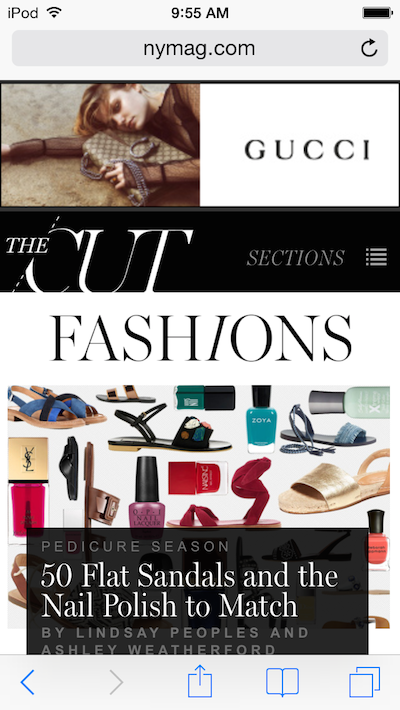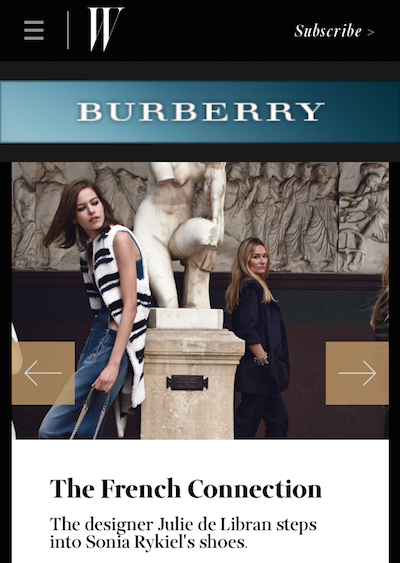Burberry most successful apparel brand on digital channels: L2
Ecommerce sales have brought the luxury goods industry to a tipping point, according to a new report by L2.
Eight-three percent of the growth in luxury in 2014 is attributable to online sales, compared to just 33 percent in 2013 and 5 percent from 2010-2012. Unlike in-store sales, online sales are not evenly distributed, meaning that accelerating online growth could shake-up the apparel industry.
“Digital IQ Index: Fashion” looks at the performance of 83 brands in the digital and ecommerce space. Among the elements considered in the score are whether features such as FAQs, geolocating, live chats and personal shoppers were displayed; the ease with which consumers can pay, add products to the cart, change color or size from cart or access a wish list from the cart; convenience rendered through shipping, return and pickup options; the sophistication of guided selling options; search visibility; social media visibility and engagement and more.
High rollers
Offline apparel sales still account for a much larger chunk of the pie, at $129 billion compared to just $210 million; however, the top 10 brands account for well under a quarter of total offline sales. By contrast, the top 10 brands online accounted for two-thirds of sales.
Although missing out on a large chunk of the $210 million online may not seem like much to brands succeeding in-store, that number, currently 6 percent of total sales, is expected to double within five years and at least triple within a decade.
“Digital IQ Index: Fashion” summary
To carve out a digital space, brands must first of all be visible online, but nearly half of fashion brands do not generate first-page hits on retail partners such as Saks Fifth Avenue and Net-A-Porter when searching for keywords. Visibility also varied across platforms, suggesting that even the most successful online retailers have room to improve.
Three-quarters of online apparel sales come from retailers, meaning that visibility on those sites and in searches will be essential for online growth. The results suggest that brands are over-indexing in terms related to primary business and neglecting visibility elsewhere.
Burberry scores the highest in L2’s Digital IQ test, beating out Kate Spade by 1 point. In addition to success on emerging platforms, updates to its mobile site have tripled while legacy investments such as “Art of the Trench” continue to find success with regional updates.
Other brands scoring in the highest “gifted” category or Ralph Lauren, Louis Vuitton, Gucci, Michael Kors, Hugo Boss, Jimmy Choo, DVF and Dolce & Gabbana. On the other end of the scale, Chloé and Pucci are “feeble” while Givenchy, Kenzo, Miu Miu, Sergio Rossi and Vivienne Westwood are “challenged.”

Gucci advertising on New York magazine’s The Cut
Those taking big steps to improve are Fendi, Hermes, Tod’s, Valentino and Belstaff, while Mulberry and Stella McCartney are falling behind. While brands are shuffling amongst one another, the percentage that fall into each of L2’s categories remain constant, suggesting a market-wide inability to adapt to a changing ecommerce landscape.
In general, Kering brands outperformed those of Prada and LVMH, with an average digital IQ of 104, compared to 94 and 92, respectively. Nevertheless, the average Kering brand’s score dropped 3 percent, compared to 11 percent gains for Prada and 5 percent for LMVH.
Interestingly, digital IQ did not align with year-to-date performance. PVH Corp. and Coach Inc., had the highest average scores but also among the biggest drops. LVMH grew more than 20 percent, whereas Prada shrunk by a third.
A large part of ecommerce growth is mobile devices, which now account for 37 percent of online sales. Among the leaders in the mobile space are Burberry and Cole Haan, who has reduced checkout from 15 clicks to a thumbprint scan with Apple Pay.
This year, desktop video ad revenue is triple that of mobile, but Business Insider predicts that by the end of the decade the two will even out. Videos garner clickthroughs at a much higher rate than display ads.
Videos are particularly well suited to social media, which tends to attract a brand’s more loyal consumers. Additionally, social videos often register as conversation starters rather than advertisements, leading to more responsive consumers.

Chanel pop-up video on Harpers Web site
Among the other findings detailed in the report, the number of unique brand ads is positively correlated with relative impressions on mobile, and brand ads on online retailers have double or triple the impression share of those on fashion, lifestyle and news sites.
Also highlighted are the omnichannel innovations of Ralph Lauren and Cole Haan. In addition to Apple Pay, Cole Haan also makes use of geofencing to drive online traffic into stores. Ralph Lauren has launched interactive fitting rooms with touchscreen mirrors to communicate with sales associates and RFID chips and readers to makes transactions or create a shopping cart online.
Get smart
To stake a large share of inevitable ecommerce growth, brands must tap into global followings. Although an ecommerce site may be successful in the United States and/or Western Europe, consumers in more distant parts of the globe will be looking for brands willing to speak to them in their own language.
Global heterogeneity presents many obstacles for brands looking to maximize their share through localization efforts, according to a September report from L2.
The share of ecommerce sales in the luxury industry has tripled since 2009 and is set to triple again by 2025, but obstacles such as currency, language, selection and payment method may make it difficult for brands to expand and capitalize on their reach. As social media, the Web and the development of BRIC, Asian and Sub-Saharan African nations give brands more visibility, it is essential that they monetize global consumers (see story).
A lack of search visibility may suggest that brands are hoping that organic traffic can elevate placement in search results. Likewise, many brands still likely believe that strong video content and social media engagement alone can drive traffic.
However, the ecommerce space is far more crowded now than before, and neglecting paid advertising means neglecting prospects. Another L2 report from earlier this year found that while quality content remains an essential factor for videos to garner attention, but advertising is key in maximizing reach and scale.
The report examines the relative successes brands have with different advertising models. In sum, content must be good enough to hold viewer attention to justify advertisement spend, but organic views rarely drive scale (see story).
Final Take
Forrest Cardamenis, editorial assistant on Luxury Daily, New York

